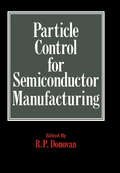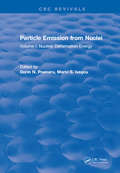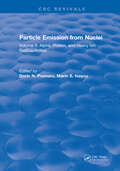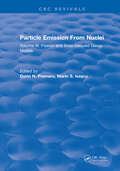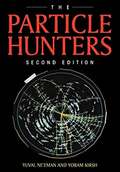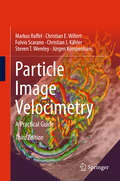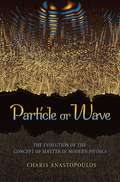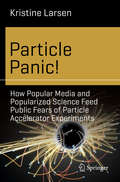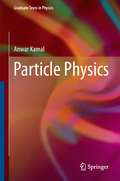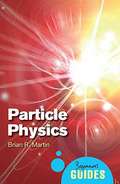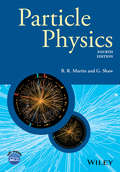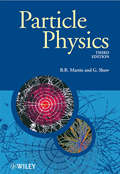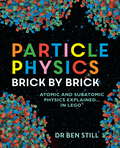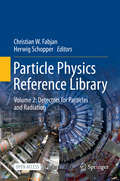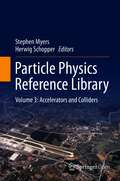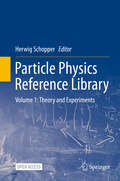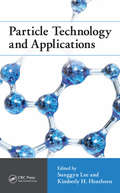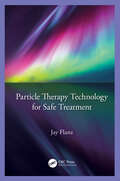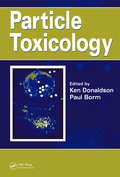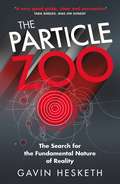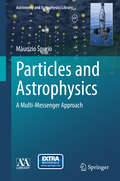- Table View
- List View
Particle Control for Semiconductor Manufacturing
by DonovanThere is something Alice-in-Wonderlandish about powerful and vital computer systems being shut down by a microscopic mote that a hay-feverist wouldn't sneeze at, but as computer chips get smaller, smaller and smaller particles on their surface have a larger and larger effect on their performance. In
Particle Dark Matter
by Gianfranco BertoneAimed at graduate students and researchers in theoretical physics, this book presents the modern theory of strong interaction: quantum chromodynamics (QCD). The book exposes various perturbative and nonperturbative approaches to the theory, including chiral effective theory, the problems of anomalies, vacuum tunnel transitions, and the problem of divergence of the perturbative series. The QCD sum rules approach is exposed in detail. A great variety of hadronic properties (masses of mesons and baryons, magnetic moments, form factors, quark distributions in hadrons, etc. ) have been found using this method. The evolution of hadronic structure functions is presented in detail, together with polarization phenomena. The problem of jets in QCD is treated through theoretical description and experimental observation. The connection with Regge theory is emphasized. The book covers many aspects of theory which are not discussed in other books, such as CET, QCD sum rules, and BFKL.
Particle emission concept and probabilistic consideration of the development of infections in systems: Dynamics from logarithm and exponent in the infection process, percolation effects
by Marcus HellwigThe book describes the possibility of making a probabilistic prognosis, which uses the mean n-day logarithm of case numbers in the past to determine an exponent for a probability density for a prognosis, as well as the particle emission concept, which is derived from contact and distribution rates that increase the exponent of the probable development to the extent that a group of people can be formed.
Particle Emission From Nuclei: Volume I: Nuclear Deformation Energy
by Dorin N. PoenaruThis book has three volume. The first volume is mainly devoted to the macroscopic-microscopic theory in its traditional form and extended to very high mass and charge asymmetry. Applications of this theory to the emission of different kinds of charged particles from nuclei are presented in the second volume, where recent experimental achievements in alpha decay, proton, and heavy ion (14C, 24Ne, 28Mg, etc.) radioactivities are also discussed. Experiments on spontaneous fission, fission isomers, and more complex phenomena like particle-accompanied fission,delayed processes: p, a, 2p, t, n, 2n, 3n, and the new mechanism of cold fission (or fission with compact shapes) are described in detail in the third volume.
Particle Emission From Nuclei: Volume II: Alpha, Proton, and Heavy Ion Radioactivities
by Dorin N. PoenaruThis book has three volume. The first volume is mainly devoted to the macroscopic-microscopic theory in its traditional form and extended to very high mass and charge asymmetry. Applications of this theory to the emission of different kinds of charged particles from nuclei are presented in the second volume, where recent experimental achievements in alpha decay, proton, and heavy ion (14C, 24Ne, 28Mg, etc.) radioactivities are also discussed. Experiments on spontaneous fission, fission isomers, and more complex phenomena like particle-accompanied fission,delayed processes: p, a, 2p, t, n, 2n, 3n, and the new mechanism of cold fission (or fission with compact shapes) are described in detail in the third volume.
Particle Emission From Nuclei: Volume III: Fission and Beta-Delayed Decay Modes
by Dorin N. Poenaru Marin S. IvaşcuThis book has three volumes. The first volume is mainly devoted to the macroscopic-microscopic theory in its traditional form and extended to very high mass and charge asymmetry. Applications of this theory to the emission of different kinds of charged particles from nuclei are presented in the second volume, where recent experimental achievements in alpha decay, proton, and heavy ion (14C, 24Ne, 28Mg, etc.) radioactivities are also discussed. Experiments on spontaneous fission, fission isomers, and more complex phenomena like particle-accompanied fission, delayed processes: p, a, 2p, t, n, 2n, 3n, and the new mechanism of cold fission (or fission with compact shapes) are described in detail in the third volume.
The Particle Hunters
by Yuval Ne'Eman Yoram KirshFrom the recent discovery of the "top quark" to the search for the Higgs particle, the frontiers of particle physics beckon the imagination. Exploring in detail the full history of particle physics, Yuval Ne'eman and Yoram Kirsh explain in an engaging, nonmathematical style the principles of modern theories such as quantum mechanics and Einstein's relativity, and they brilliantly succeed in conveying to the reader the excitement that accompanied the original discoveries. The book is spiced with amusing stories on how great discoveries were made, and Ne'eman, who took an active role in some of the historical advances in particle physics, gives his personal point of view. New to this edition are sections on the discovery of the top quark; the rise and fall of the supercollider project; the detection of the Zo particle in e+e- colliders; and the use of the width of the Zo to determine the number of "generations" of quarks and leptons. The Particle Hunters will interest anyone who wants to keep pace with the progress of human knowledge. Yuval Ne'eman discovered the basic symmetry of the subatomic particles of matter, leading him to their classification, to the prediction of new particles, and to his identification (in 1962) of a new layer in the structure of matter ("quarks"). Yoram Kirsh was awarded the Aharon Katzir Prize for popular science writing in 1975.
Particle Image Velocimetry: A Practical Guide (Experimental Fluid Mechanics Ser. #112)
by Jürgen Kompenhans Markus Raffel Christian E. Willert Fulvio Scarano Christian J. Kähler Steven T. WereleyThis immensely practical guide to PIV provides a condensed, yet exhaustive guide to most of the information needed for experiments employing the technique. This second edition has updated chapters on the principles and extra information on microscopic, high-speed and three component measurements as well as a description of advanced evaluation techniques. What’s more, the huge increase in the range of possible applications has been taken into account as the chapter describing these applications of the PIV technique has been expanded.
Particle or Wave: The Evolution of the Concept of Matter in Modern Physics
by Charis AnastopoulosParticle or Wave is the first popular-level book to explain the origins and development of modern physical concepts about matter and the controversies surrounding them. The dichotomy between particle and wave reflects a dispute--whether the universe's most elementary building blocks are discrete or continuous in nature--originating in antiquity when philosophers first speculated about the makeup of the physical world. Charis Anastopoulos examines two of the earliest known theories about matter--the atomic theory, which attributed all physical phenomena to atoms and their motion in the void, and the theory of the elements, which described matter as consisting of the substances earth, air, fire, and water. He then leads readers up through the ages to the very frontiers of modern physics to reveal how these seemingly contradictory ideas still lie at the heart of today's continuing debates. Anastopoulos explores the revolutionary contributions of thinkers like Nicolas Copernicus, Isaac Newton, and Albert Einstein. He shows how Einstein's ideas about relativity unify opposing concepts by identifying matter with energy, and how quantum mechanics goes even further by postulating the coexistence of the particle and the wave descriptions. Anastopoulos surveys the latest advances in physics on the fundamental structure of matter, including the theories of quantum fields and elementary particles, and new cutting-edge ideas about the unification of all forces. This book reveals how the apparent contradictions of particle and wave reflect very different ways of understanding the physical world, and how they are pushing modern science to the threshold of new discoveries.
Particle Panic!: How Popular Media and Popularized Science Feed Public Fears of Particle Accelerator Experiments (Science and Fiction)
by Kristine LarsenFrom novels and short stories to television and film, popular media has made a cottage industry of predicting the end of the world will be caused by particle accelerators. Rather than allay such fears, public pronouncements by particle scientists themselves often unwittingly fan the flames of hysteria. This book surveys media depictions of particle accelerator physics and the perceived dangers these experiments pose. In addition, it describes the role of scientists in propagating such fears and misconceptions, offering as a conclusion ways in which the scientific community could successfully allay such misplaced fears through more effective communication strategies. The book is aimed at the general reader interested in separating fact from fiction in the field of high-energy physics, at science educators and communicators, and, last but not least, at all scientists concerned about these issues. About the Author Kristine M Larsen holds a Ph.D. in Physics and is currently a professor at Central Connecticut State University, New Britain, CT, in the Geological Sciences Department. She has published a number of books, among them The Women Who Popularized Geology in the 19th Century (Springer, 2017), The Mythological Dimensions of Neil Gaiman (eds. Anthony Burdge, Jessica Burke, and Kristine Larsen. Kitsune Press, 2012. Recipient of the Gold Medal for Science Fiction/Fantasy in the 2012 Florida Publishing Association Awards), The Mythological Dimensions of Doctor Who (eds. Anthony Burdge, Jessica Burke, and Kristine Larsen. Kitsune Press, 2010), as well as Stephen Hawking: A Biography (Greenwood Press, 2005) and Cosmology 101 (Greenwood Press, (2007).
Particle Physics
by Anwar KamalThis textbook teaches particle physics very didactically. It supports learning and teaching with numerous worked examples, questions and problems with answers. Numerous tables and diagrams lead to a better understanding of the explanations. The content of the book covers all important topics of particle physics: Elementary particles are classified from the point of view of the four fundamental interactions. The nomenclature used in particle physics is explained. The discoveries and properties of known elementary particles and resonances are given. The particles considered are positrons, muon, pions, anti-protons, strange particles, neutrino and hadrons. The conservation laws governing the interactions of elementary particles are given. The concepts of parity, spin, charge conjugation, time reversal and gauge invariance are explained. The quark theory is introduced to explain the hadron structure and strong interactions. The solar neutrino problem is considered. Weak interactions are classified into various types, and the selection rules are stated. Non-conservation of parity and the universality of the weak interactions are discussed. Neutral and charged currents, discovery of W and Z bosons and the early universe form important topics of the electroweak interactions. The principles of high energy accelerators including colliders are elaborately explained. Additionally, in the book detectors used in nuclear and particle physics are described. This book is on the upper undergraduate level.
Particle Physics: A Beginner's Guide (Beginner's Guides)
by Brian R. MartinGaining a following since the launch of the infamous Large Hadron Collider, particle physics explores our most fundamental and mind-blowing questions: How did the Universe start? What are we made of? How small is the smallest thing? Without presuming any prior scientific knowledge, Brian R. Martin takes readers on a wide-ranging tour of the field, from its beginnings in nuclear physics to the discovery of quarks and cutting-edge research into string theory, the mystery of antimatter, and the current search for the elusive "God particle." Brian R. Martin is emeritus professor of physics at University College London, where he chaired the physics department until 2004.
Particle Physics: University Of California, Irvine, December 1971 (Manchester Physics Ser. #45)
by Graham Shaw B. R. MartinAn accessible and carefully structured introduction to Particle Physics, including important coverage of the Higgs Boson and recent progress in neutrino physics. Fourth edition of this successful title in the Manchester Physics series Includes information on recent key discoveries including: An account of the discovery of exotic hadrons, beyond the simple quark model; Expanded treatments of neutrino physics and CP violation in B-decays; An updated account of 'physics beyond the standard model', including the interaction of particle physics with cosmology Additional problems in all chapters, with solutions to selected problems available on the book's website Advanced material appears in optional starred sections
Particle Physics
by Graham Shaw Brian MartinAn essential introduction to particle physics, with coverage ranging from the basics through to the very latest developments, in an accessible and carefully structured text.Particle Physics: Third Edition is a revision of a highly regarded introduction to particle physics. In its two previous editions this book has proved to be an accessible and balanced introduction to modern particle physics, suitable for those students needed a more comprehensive introduction to the subject than provided by the 'compendium' style physics books.In the Third Edition the standard model of particle physics is carefully developed whilst unnecessary mathematical formalism is avoided where possible. Emphasis is placed on the interpretation of experimental data in terms of the basic properties of quarks and leptons.One of the major developments of the past decade has been the establishing of the existence of neutrino oscillations. This will have a profound effect on the plans of experimentalists. This latest edition brings the text fully up-to-date, and includes new sections on neutrino physics, as well as expanded coverage of detectors, such as the LHC detector.End of chapter problems with a full set of hints for their solutions provided at the end of the book.An accessible and carefully structured introduction to this demanding subject.Includes more advanced material in optional 'starred' sections.Coverage of the foundations of the subject, as well as the very latest developments.
Particle Physics Brick by Brick
by Dr Ben StillUsing LEGO® blocks to create a uniquely visual and clear depiction of the way our universe is put together. This is the perfect introduction to the enigmatic and fascinating world of Quantum Physics.Our story starts with the Big Bang, and along the way, the constructs and interactions within and among atoms and sub-atomic particles, and the forces that play upon them, are clearly explained, with each LEGO® block representing a different atomic or sub-atomic particle. The different colours and size denote what that particle is and its relationship with the other 'building blocks'.Each chapter is presented in digestible chunks, using toy building blocks to illustrate the ideas and experiments that have led to some of the biggest discoveries of the past 150 years.Soon you'll be able to construct every element in the Universe using a box of LEGO® and this book!
Particle Physics of Brane Worlds and Extra Dimensions
by Sreerup Raychaudhuri K. SridharThe possibility that we live in a higher-dimensional world with spatial dimensions greater than three started with the early work of Kaluza and Klein. However, in addressing experimental constraints, early model-builders were forced to compactify these extra dimensions to very tiny scales. With the development of brane-world scenarios it became possible to consider novel compactifications which allow the extra dimensions to be large or to provide observable effects of these dimensions at experimentally accessible energy scales. This book provides a comprehensive account of these recent developments, keeping the high-energy physics implications in focus. After an historical survey of the idea of extra dimensions, the book deals in detail with models of large extra dimensions, warped extra dimensions and other models such as universal extra dimensions. The theoretical and phenomenological implications are discussed in a pedagogical manner for both researchers and graduate students.
Particle Physics Reference Library: Volume 2: Detectors for Particles and Radiation
by Christian W. Fabjan Herwig SchopperThis second open access volume of the handbook series deals with detectors, large experimental facilities and data handling, both for accelerator and non-accelerator based experiments. It also covers applications in medicine and life sciences. A joint CERN-Springer initiative, the “Particle Physics Reference Library” provides revised and updated contributions based on previously published material in the well-known Landolt-Boernstein series on particle physics, accelerators and detectors (volumes 21A,B1,B2,C), which took stock of the field approximately one decade ago. Central to this new initiative is publication under full open access.
Particle Physics Reference Library: Volume 3: Accelerators and Colliders
by Stephen Myers Herwig SchopperThis third open access volume of the handbook series deals with accelerator physics, design, technology and operations, as well as with beam optics, dynamics and diagnostics. A joint CERN-Springer initiative, the “Particle Physics Reference Library” provides revised and updated contributions based on previously published material in the well-known Landolt-Boernstein series on particle physics, accelerators and detectors (volumes 21A,B1,B2,C), which took stock of the field approximately one decade ago. Central to this new initiative is publication under full open access
Particle Physics Reference Library: Volume 1: Theory and Experiments
by Herwig SchopperThis first open access volume of the handbook series contains articles on the standard model of particle physics, both from the theoretical and experimental perspective. It also covers related topics, such as heavy-ion physics, neutrino physics and searches for new physics beyond the standard model. A joint CERN-Springer initiative, the “Particle Physics Reference Library” provides revised and updated contributions based on previously published material in the well-known Landolt-Boernstein series on particle physics, accelerators and detectors (volumes 21A,B1,B2,C), which took stock of the field approximately one decade ago. Central to this new initiative is publication under full open access.
Particle Technology and Applications (Green Chemistry and Chemical Engineering)
by Sunggyu Lee Kimberly H. HenthornParticle Technology and Applications presents the theoretical and technological background of particle science and explores up-to-date applications of particle technologies in the chemical, petrochemical, energy, mechanical, and materials industries. It looks at the importance of particle science and technology in the development of efficient chemi
Particle Therapy Technology for Safe Treatment
by Jay FlanzThe path from clinical requirements to technical implementation is filtered by the translation of the modality to the technology. An important part of that filter is that the modality be safe. For that to be the case, it is imperative to understand what clinical parameters affect the safety of a treatment and then determine how the technology can affect those parameters. This book provides a practical introduction to particle therapy. It provides a thorough introduction to the technological tools and their applications and then details the components that are needed to implement them. It explains the foundations of beam production and beam delivery that serve to meet the necessary clinical requirements. It emphasizes the relationship between requirements and implementation, including how safety and quality are considered and implemented in the solution. The reader will learn to better understand what parameters are important to achieve these goals. Particle Therapy Technology for Safe Treatment will be a useful resource for professionals in the field of particle therapy in addition to biomedical engineers and practitioners in the field of beam physics. It can also be used as a textbook for graduate medical physics and beam physics courses. Key Features Presents a practical and accessible journey from application requirements to technical solutions Provides a pedagogic treatment of the underlying technology Describes how safety is to be considered in the application of this technology and how safety and quality can be factored into the overall system Author Bio After receiving his PhD in nuclear physics, Dr. Jacob Flanz was the Accelerator Physics Group leader and Principal Research Scientist at the Massachusetts Institute of Technology (MIT), USA, where he designed the recirculator and the GeV stretcher/storage ring. He joined Massachusetts General Hospital (MGH) and Harvard and became project and technical director of proton therapy, with responsibility for specifications, integration, and commissioning ensuring safe clinical performance. He invented the universal nozzle and led the design and implementation of beam scanning at MGH in 2008, including quality assurance. Dr. Flanz has been involved in several FDA applications for particle therapy. He developed and taught the US Particle Accelerator School course "Medical Applications of Accelerators and Beams." He was cochair of education and is currently the president of the Particle Therapy Co-Operative Group.
Particle Toxicology
by Ken Donaldson Paul BormExposure to particles in industry and mining and from accidental anthropogenic sources constitutes an ongoing threat. Most recently nanoparticles arising from advances in technology are exposing a wider population to pathogenic stimuli. The effects of inhaled particles are no longer confined to the lung as nanoparticles have the potential to transl
The Particle Zoo: The Search for the Fundamental Nature of Reality
by Gavin HeskethWhat is everything really made of? If we split matter down into smaller and infinitesimally smaller pieces, where do we arrive? At the Particle Zoo - the extraordinary subatomic world of antimatter, ghostly neutrinos, strange-flavoured quarks and time-travelling electrons, gravitons and glueballs, mindboggling eleven-dimensional strings and the elusive Higgs boson itself.Be guided around this strangest of zoos by Gavin Hesketh, experimental particle physicist at humanity's greatest experiment, the Large Hadron Collider. Concisely and with a rare clarity, he demystifies how we are uncovering the inner workings of the universe and heading towards the next scientific revolution.Why are atoms so small? How did the Higgs boson save the universe? And is there a Theory of Everything? The Particle Zoo answers these and many other profound questions, and explains the big ideas of Quantum Physics, String Theory, The Big Bang and Dark Matter... and, ultimately, what we know about the true, fundamental nature of reality.
The Particle Zoo: The Search for the Fundamental Nature of Reality
by Gavin HeskethWhat is everything really made of? If we split matter down into smaller and infinitesimally smaller pieces, where do we arrive? At the Particle Zoo - the extraordinary subatomic world of antimatter, ghostly neutrinos, strange-flavoured quarks and time-travelling electrons, gravitons and glueballs, mindboggling eleven-dimensional strings and the elusive Higgs boson itself.Be guided around this strangest of zoos by Gavin Hesketh, experimental particle physicist at humanity's greatest experiment, the Large Hadron Collider. Concisely and with a rare clarity, he demystifies how we are uncovering the inner workings of the universe and heading towards the next scientific revolution.Why are atoms so small? How did the Higgs boson save the universe? And is there a Theory of Everything? The Particle Zoo answers these and many other profound questions, and explains the big ideas of Quantum Physics, String Theory, The Big Bang and Dark Matter... and, ultimately, what we know about the true, fundamental nature of reality.
Particles and Astrophysics
by Maurizio SpurioThis book is an introduction to "multi-messenger" astrophysics. It covers the many different aspects connecting particle physics with astrophysics and cosmology and introduces astrophysics using numerous experimental findings recently obtained through the study of high-energy particles. Taking a systematic approach, it comprehensively presents experimental aspects from the most advanced laboratories and detectors, as well as the theoretical background. The book is aimed at graduate students and post-graduate researchers with a basic understanding of particle and nuclear physics. It will also be of interest to particle physicists working in accelerator/collider physics who are keen to understand the mechanisms of the largest accelerators in the Universe. The book draws on the extensive lecturing experience of Professor Maurizio Spurio from the University of Bologna.
